 by "ttyymmnn" (ttyymmnn)
by "ttyymmnn" (ttyymmnn)
Published 12/19/2017 at 12:35
 by "ttyymmnn" (ttyymmnn)
by "ttyymmnn" (ttyymmnn)
Published 12/19/2017 at 12:35
Tags: planelopnik history
; Planelopnik
STARS: 10
!!! UNKNOWN CONTENT TYPE !!!
Welcome to
This Date in Aviation History
, getting of you caught up on milestones, important historical events and people in aviation from December 16 through December 19.
!!! UNKNOWN CONTENT TYPE !!!
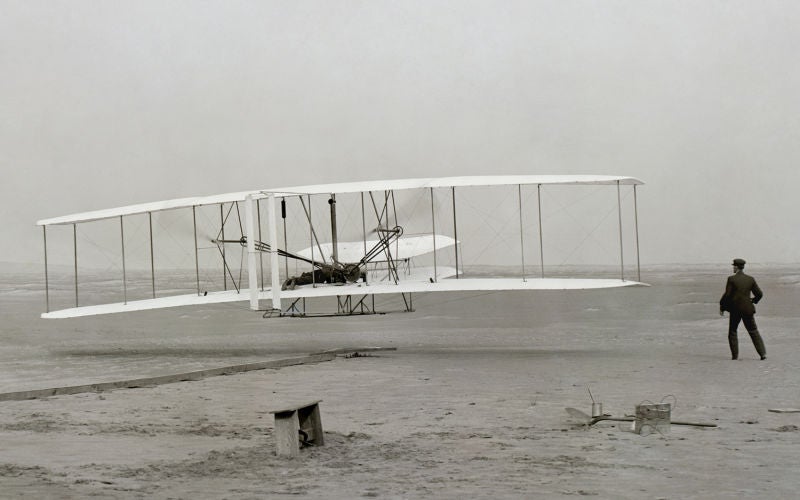
December 17, 1903 – The Wright Brothers make the first powered flight in the world’s first practical airplane. While the Wright Brothers were not the first to fly, Wilbur and Orville were the first to build and fly a heavier-than-air aircraft under its own power and control the aircraft in flight. After a series of tests of gliders to perfect their designs, the brothers set up shop at Kill Devil Hills, North Carolina to make their first attempts at powered flight. After tossing a coin to decide who would take the controls on the first flight, Orville took off, with Wilbur running alongside, and flew the aircraft for 12 seconds and covered a distance of 120 feet. Subsequent flights managed distances of 175 feet and 200 feet.
Read more about the Wright Brothers and their world-changing first flight at Wingspan.
!!! UNKNOWN CONTENT TYPE !!!
!!! UNKNOWN CONTENT TYPE !!!
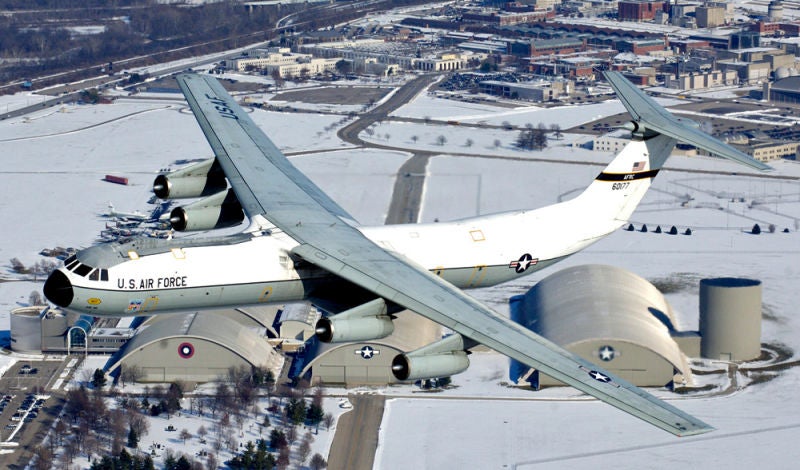
December 17, 1963 – The first flight of the Lockheed C-141 Starlifter. Napoleon (or perhaps Frederick the Great) famously said that an army marches on its stomach, and experience in WWII demonstrated the true potential of the airplane as a means of delivering supplies and materiel to front line troops. By the early 1960s, the US Air Force needed a new, jet-powered transport and cargo aircraft to replace its aging fleet of piston-powered transports such as the C-124 Globemaster II . As a stopgap measure, the Air Force ordered the Boeing C-135 Stratolifter , a cargo variant of the KC-135 aerial tanker, but without any specific logistic capabilities, such as clamshell doors, the C-135 was an imperfect solution. In 1960, the Air Force released Specific Operational Requirement 182, which called for an aircraft that could perform both strategic and tactical airlift missions. For the strategic mission, the new airlifter would need a range of at least 3,500 nautical miles while carrying a 60,000-pound load of troops, equipment or materiel. Tactically, the new aircraft would have to be capable of performing low-altitude air drops of materiel and paratroops. Boeing, General Dynamics and Lockheed responded to the proposal, and the Starlifter was chosen.
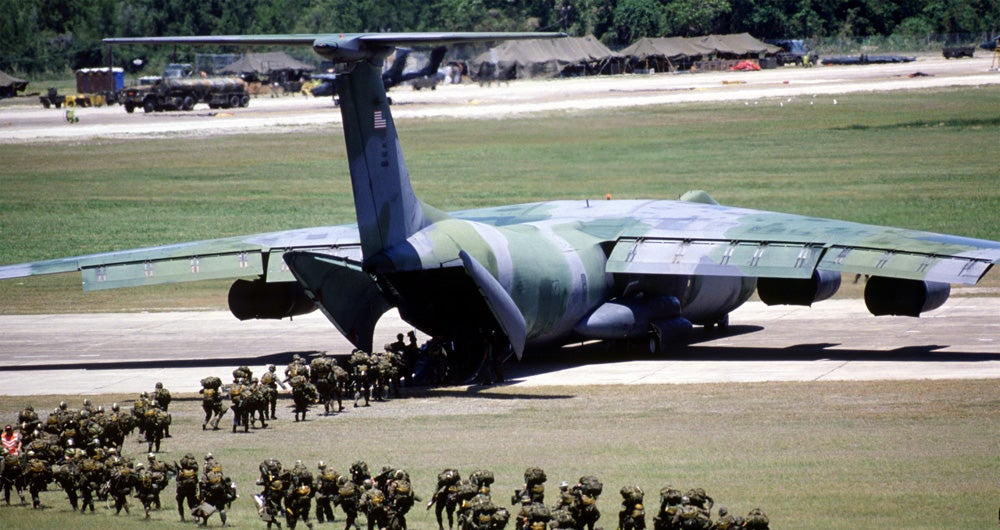
The C-141, which had the Lockheed designation Model 300, was designed from the outset as a cargo aircraft, with a high wing that allowed for maximum cargo space and a clamshell door at the rear. Another important feature is a cargo floor that is just 50 inches above the ground, facilitating access to the cargo hold for troops and vehicles. The Starlifter was powered by four Pratt & Whitney TF33 turbofans, and the large hold could carry over 70,000 pounds of cargo. The the C-141 set a world record for heavy cargo drops with a load of 70,195 pounds.

As a personnel carrier, the Starlifter could accommodate 154 troops, 123 paratroops or 80 medevac patients on litters. Though the Starlifter was large and powerful, one of the drawbacks of the original C-141 was that it tended to fill up with bulky equipment before it reached its cargo weight limit. To address this problem, Lockheed took 270 C-141As and lengthened them by 23 feet by adding an additional fuselage section, and the new aircraft was designated C-141B. The Starlifter entered service in 1965 and had an immediate impact on American operations in Vietnam, carrying troops and supplies to Asia and returning with wounded soldiers. During the Gulf War of 1991, Starlifters performed the bulk of strategic airlift missions, transporting 159,462 short tons of cargo and 93,126 passengers over the course of 8,536 missions. The Starlifter became one of the longer-serving aircraft in the Air Force inventory, and its retirement in 2006 ended 41 years of service. A total of 285 C-141s were produced from 1963 to 1968. (US Air Force photos)
The aircraft in the top photo, tail number 66-0177, better known as the Hanoi Taxi , was the aircraft that brought home the first US prisoners of war to be released from North Vietnam. First delivered to the Air Force in 1967, the Hanoi Taxi was the final C-141 to be withdrawn from Air Force service when the Starlifter was retired from active service in 2006. The Hanoi Taxi is now housed at the National Museum of the United States Air Force, shown in the background of the photo.
!!! UNKNOWN CONTENT TYPE !!!

December 17, 1947 – The first flight of the Boeing B-47 Stratojet. By the end of WWII, the race was on to harness the power of the new jet engine in all applications of military flight. Following the development of jet-powered fighters, a jet-powered bomber was the next logical step. As early as 1943, the US Army Air Forces asked aircraft designers to start looking at a large bomber that would be powered by jets, and, in 1944, North American Aviation, the Convair Corporation, the Glenn Martin Company, and Boeing all submitted proposals for a traditional, straight-winged aircraft with turbojet engines. All were powered by the new General Electric TG-180 turbojet (GE’s designation of the Allison J35), and Boeing’s design, which they designated the Model 432, had its engines buried in the fuselage to reduce drag.
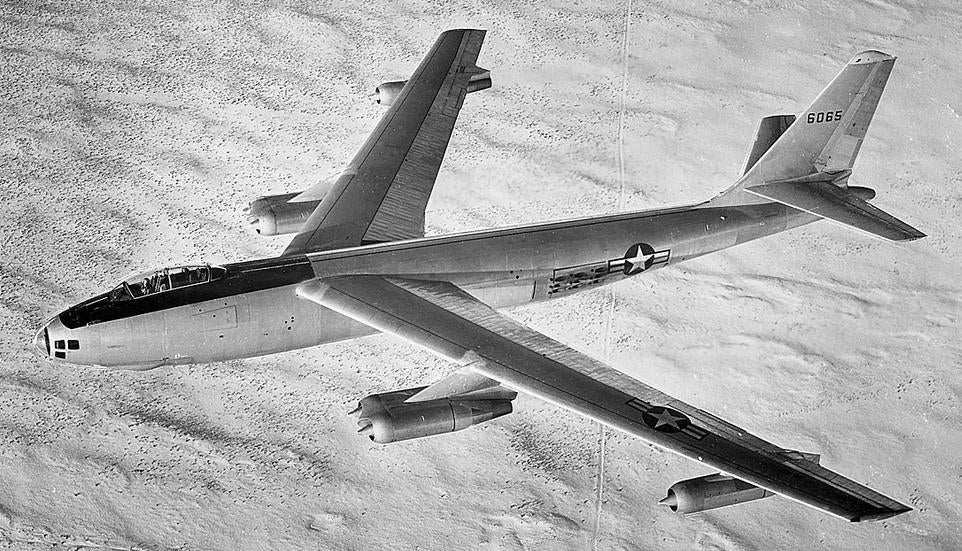
In May 1945, with WWII drawing to a close, the Allies drove deeper into Germany and began to discover secret German weapons and aircraft facilities, and much of the data from German testing programs fell into Allied hands. One of those locations was an aircraft development site in Braunschweig, where the Germans had been working on swept wing technology. Work was already under way in the US to investigate the benefits of sweeping the wings of an aircraft, and the German data verified the benefits of the concept. A Boeing engineer, George Schairer, who was on the American inspection team in Germany, called back to Boeing and instructed them to stop work on the new bomber and to begin a redesign to incorporate a swept wing. Based on the captured German data, a sweep of 35-degrees was incorporated into both the main wing and the tailplane, and the engines were moved from the fuselage to pods under the wings, a configuration of swept wings and podded engines that set the standard for large jet aircraft design that remains standard to this day. The thin wing did not allow for traditional landing gear, so a bicycle gear arrangement was employed, with outrigger wheels fitted to the inboard engine pods. While the B-47 was not supersonic, it was still quite fast, and the Stratojet set a record for transcontinental flight when it crossed the US in less than four hours at an average speed of 698 mph.
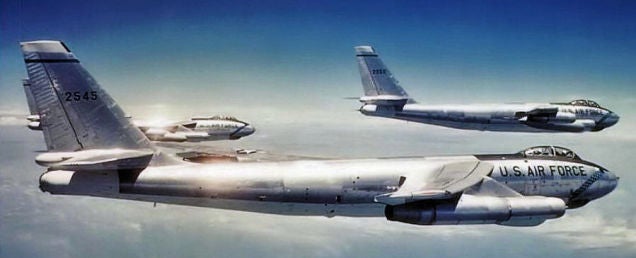
The B-47 served as the cornerstone of the Strategic Air Command’s nuclear deterrence force until it was replaced by the larger Boeing B-52 Stratofortress , and, while the Stratojet never saw combat, its reconnaissance variants provided vital surveillance data, as well as electronic intelligence and weather reconnaissance. A total of 2,032 Stratojets were produced, a number that includes 659 that were built under license by Douglas and Lockheed. The final bomber variant, the B-47E, was retired in 1969, while the reconnaissance variant EB-47E served until 1977. No airworthy Stratojets remain today, though 23 are on display around the country. (US Air Force photos)
!!! UNKNOWN CONTENT TYPE !!!

December 17, 1935 – The first fight of the Douglas DC-3/C-47 Skytrain. Throughout the history of aviation, there have been many great airplanes, but only a few can be counted in the pantheon of the greatest ever. And it seems fitting that, in a world of computers, jet engines, and fly-by-wire controls, one of the aircraft that truly changed the world is an unassuming propeller plane, one that revolutionized the world of air transport and also played an indispensable role in winning WWII. That aircraft is the Douglas DC-3, or, in its military guise, the C-47 Skytrain.
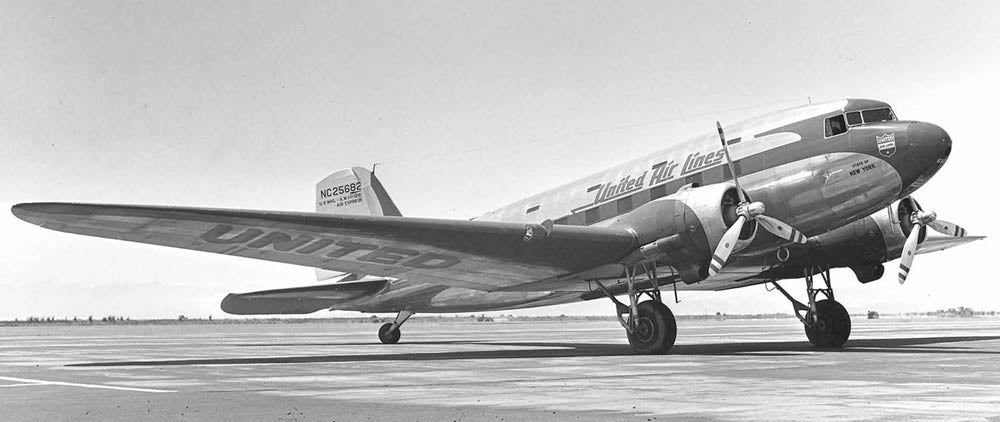
By the 1930s, aircraft designers were competing to develop larger passenger aircraft to fill the needs of a burgeoning air travel industry. Transcontinental and Western Air (which later became Trans World Airlines, or TWA) was in stiff competition with United and their Boeing 247 , and the growing company needed a modern airliner of their own. Since Boeing was in an exclusive contract with United (which was owned by Boeing), T&WA approached the Douglas Aircraft Company to build a new airliner for their own use. That request resulted in the DC-2 (“DC” stands for “Douglas Commercial”), an excellent plane in its own right, but one that could still be improved upon. After discussions with American Airlines, Douglas began development of what they called the Douglas Sleeper Transport (DST), and began by widening the DC-2 so it could accommodate 14 to 16 side-by-side berths. With the berths removed and seats put in their place, the DST could hold 21 passengers, and this configuration received the designation DC-3. The DC-3 was an immediate success, crossing the country from west to east in as little as 15 hours (with three stops for fuel). Douglas produced just over 600 DC-3s, but it was the outbreak of WWII that pushed the DC-3 into the record books and into the annals of history.

For military service, Douglas fitted more powerful engines, strengthened the floor to support military cargo, and removed the seats, replacing them with utility seats that lined the cabin walls. A large door was also added to the side of the plane to facilitate loading and unloading of cargo. The military version received the designation C-47 Skytrain (it was known as the R4D in US Navy service, and the Dakota by the British), and it proved indispensable in flying cargo missions over the Himalayas, and supplied troops in every theater of operations in WWII. It also towed gliders for airborne troops, and flew paratroops into battle. The C-47 proved to be extremely rugged and easy to maintain in the field, and Allied commanders, particularly in the Pacific, found that entire armies could now be supplied by the air. General Dwight D. Eisenhower, Supreme Commander of Allied forces in Europe, said that the C-47 was one of the major tools that helped win the war for the Allies. While “only” 607 DC-3s were built, over 10,000 C-47s were produced in a myriad of variants, with many still flying today. And, while historians make note of aircraft that have flown for over 50 years, there is every possibility that the rugged and reliable DC-3/C-47 will still be flying 100 years after its introduction. (Photo by Bill Larkins via Wikimedia Commons ; photo by Bill Larkins via Wikimedia Commons ; US Air Force photo)
!!! UNKNOWN CONTENT TYPE !!!
!!! UNKNOWN CONTENT TYPE !!!
!!! UNKNOWN CONTENT TYPE !!!
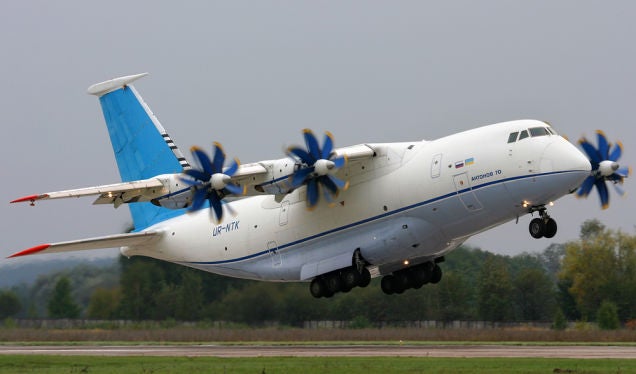
December 16, 1994 – The first flight of the Antonov An-70.
Developed in the 1980s to replace the
Antonov An-12
, the An-70 is the first large aircraft to be powered by
propfan
engines, a jet engine in which one or more stages of the turbine fan is outside the engine cowling. The Soviet government originally intended to build as many as 160 An-70s in factories in both Russia and Ukraine, but the
dissolution
of the Soviet Union in 1991 led to the cancellation of the project. Only two prototypes were built, the first of which was lost in a mid-air collision in 1995. There were plans to resurrect the project, but Russia declared in 2015 that they had no intention of procuring the An-70.
(Photo by Oleg V. Belyakov via
Wikimedia Commons
)
!!! UNKNOWN CONTENT TYPE !!!

December 16, 1990 – The death of Douglas Campbell. At the outbreak of WWI, the United States lagged behind the rest of Europe in the development of military aircraft, and many Americans went overseas to fly for the British and French. By 1917, the first fully American squadrons arrived in France, though they were still flying French aircraft, and one of the first to see action was the 94th Aero Squadron , better known as the Hat in the Ring. When the US entered the war in 1917, Campbell dropped out of Harvard and joined the US Army, where he learned to fly in a Curtiss Jenny . Campbell took part in the 94th’s first combat patrol alongside famed aviators Eddie Rickenbacker and Raoul Lufbery , and scored his first victory in an aircraft armed with only a single machine gun rather than the customary two. Campbell became the first US aviator to become an ace while flying for an American unit, and ended the war with six victories, earning the Distinguished Service Cross and Croix de Guerre . (US Army photo)
!!! UNKNOWN CONTENT TYPE !!!
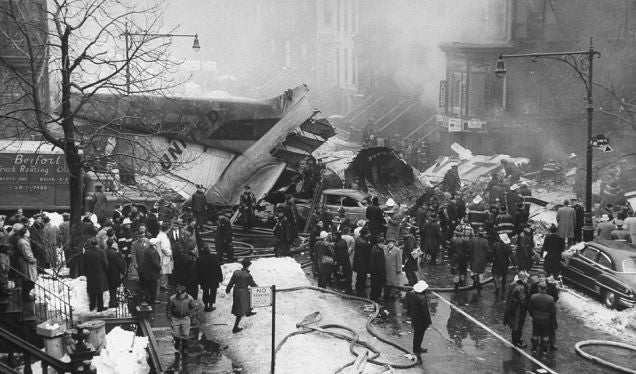
December 16, 1960 – Two airliners collide over Staten Island, New York.
In what has become known as the Park Slope plane crash, United Airlines Flight 826, a
Douglas DC-8
(N8013U) carrying 84 passengers and bound for Idlewild Airport (later JFK International) collided with TWA Flight 266, a
Lockheeed L-1049 Super Constellation
(N6907C) carrying 44 passengers also en route to Idlewild, killing all but one on board the two airliners along with six people on the ground. The sole survivor, 11-year-old Steven Baltz, died the next day from complications caused by inhalation of burning jet fuel. Using information from the
flight recorders
(commonly known as “black boxes”) for the first time since their use was mandated in 1957, investigators found that a faulty VHF transmitter contributed to the United crew’s overshooting their holding point, which caused it to cross paths with the TWA flight. The loss of 134 people was the world’s deadliest crash until 1968, when a US Air Force
Lockheed C-130 Hercules
was
shot down
over South Vietnam, killing 155, mostly South Vietnamese civilians, being evacuated from the
Battle of Kham Duc
.
(Photo by Time Life via
Daily Mail
)
!!! UNKNOWN CONTENT TYPE !!!
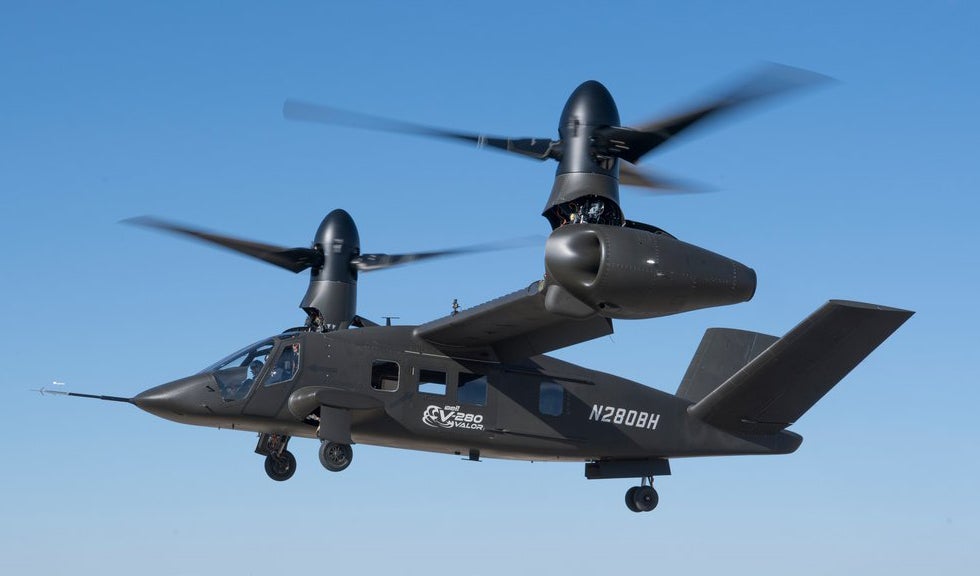
December 17, 2017 – The first flight of the Bell V-280 Valor, a tiltrotor aircraft being developed for the US Army by Bell Helicopter and Lockheed Martin. The Valor was selected in 2013 as a technology demonstrator for the Army’s Future Vertical Lift program which seeks replacements for the UH-60 Black Hawk , AH-64 Apache , CH-47 Chinook , and OH-58 Kiowa . While bearing a resemblance to the V-22 Osprey, the major difference with the Valor is that, while the entire engine pod rotates on the Osprey for vertical and horizontal flight, only the gearbox rotates on the Valor. Other design elements include a V tail, a carbon fiber reinforced polymer wing for weight reduction, and triple-redundant fly-by-wire controls. In the event of engine failure, one engine will be capable of turning both props. The Valor will have a crew of 4, room for 14 troops, and, as its designation indicates, a top speed of 280 knots. (Bell Helicopter photo via The Aviationist )
!!! UNKNOWN CONTENT TYPE !!!
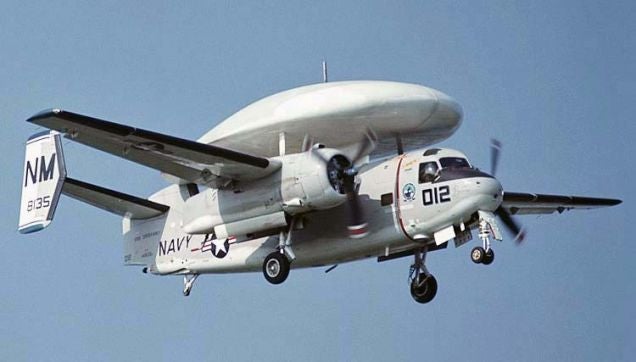
December 17, 1956 – The first flight of the Grumman E-1 Tracer. A development of the Grumman C-1 Trader , which was designed for carrier onboard delivery (COD), and itself a variant of the Grumman S-2 Tracker , the Tracer was the first purpose-built carrier-borne airborne early warning (AEW) aircraft. The original E-1 was fitted with the Hazeltine AN/APS-82 radar in a large radome above the fuselage to track enemy aircraft, and had the critical capability of being able to separate targets from the background of the ocean’s surface. The Tracer entered service in 1958 with the understanding that it was only an interim design before a more modern aircraft could be developed, and 83 were produced before being replaced by the Grumman E-2 Hawkeye . (Photo author unknown)
!!! UNKNOWN CONTENT TYPE !!!
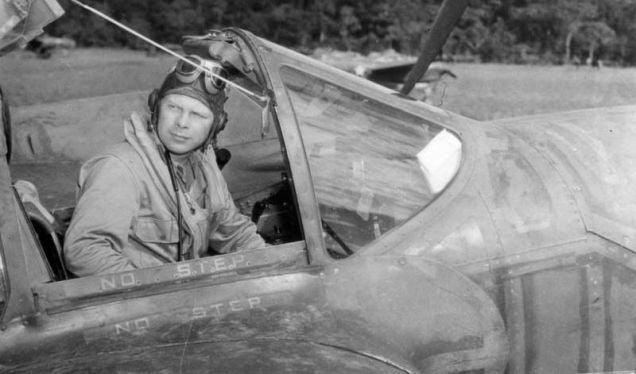
December 17, 1944 – Major Richard Bong becomes the top-scoring American fighter ace of WWII. One of America’s most highly decorated fighter pilots, Bong amassed a total of 40 victories over Japanese aircraft in the Pacific Theater, all of which he scored while flying the Lockheed P-38 Lightning . In September 1942, Bong scored his first two victories, earning him the Silver Star , and in July 1943 he shot down four Japanese fighters over Lae, New Guinea, earning him the Distinguished Flying Cross . While assigned to non-combat role as a gunnery instructor, Bong downed eight enemy aircraft, earning him the Congressional Medal of Honor . Bong was sent home in 1945 to sell war bonds as the “ace of aces,” but was killed in August of that year while flying as a test pilot in a Lockheed P-80 Shooting Star . (US Army photo)
!!! UNKNOWN CONTENT TYPE !!!
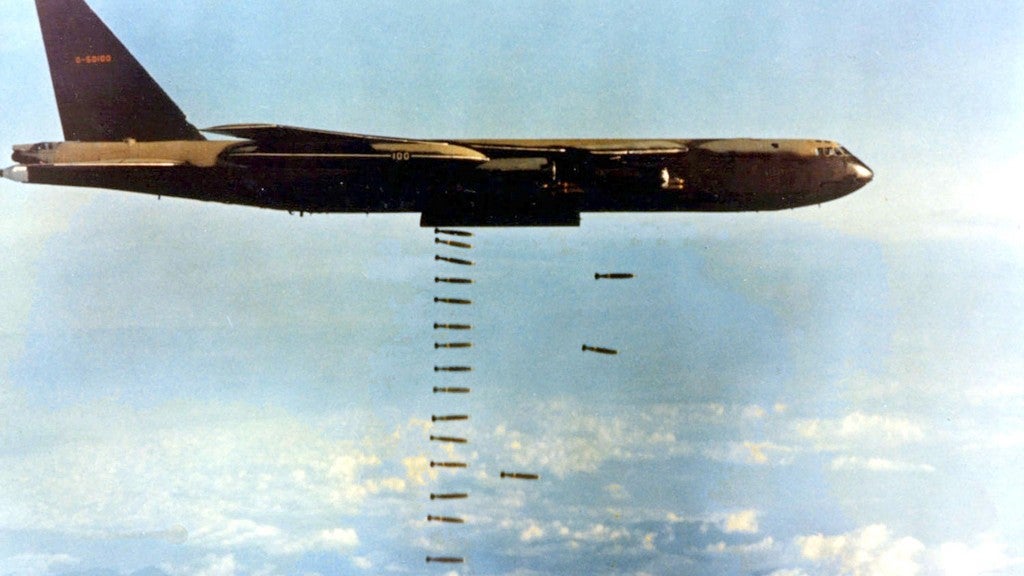
December 18, 1972 – The beginning of the Linebacker II bombing campaign in Vietnam. As the war in Vietnam ground to its ultimate conclusion in 1974, elements of the US Seventh Air Force and US Navy Task Force 77 carried out a bombing campaign of “maximum effort” to destroy targets in the Hanoi, the capital of North Vietnam, and the strategic harbor at Haiphong in an effort to get the North Vietnamese government to return to negotiations. Over the course of 11 days, the bombings, also known as the Christmas Bombings, were carried out by over 2,000 US aircraft, including more than 200 Boeing B-52 Stratofortress bombers, in the heaviest aerial bombardment since WWII. B-52s performed 741 sorties and dropped 15,237 tons of ordnance in industrial, military, and antiaircraft missile sites, with an additional 5,000 tons of bombs dropped by Navy and Air Force fighter bombers. Sixteen B-52s were lost, while North Vietnam claimed 1,624 civilian casualties. Though the bombing was popular with supporters of the war, the effectiveness of the missions was questionable, and President Nixon said they amounted to “zilch.” (US Air Force photo)
!!! UNKNOWN CONTENT TYPE !!!
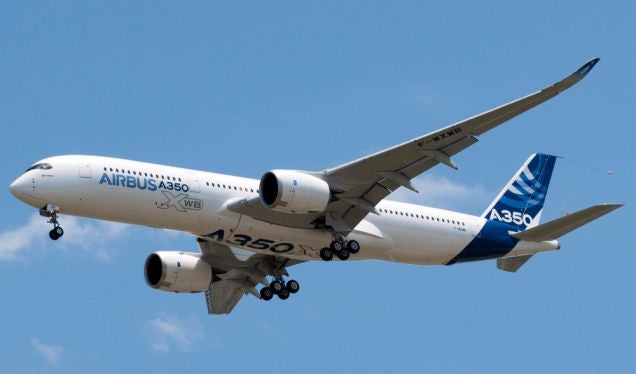
December 18, 1970 – Airbus Industries is formally established.
In an effort to compete with American aircraft manufactures Boeing, McDonnell Douglas and Lockheed, Airbus was formed by an agreement between French Aerospatiale, German Deutsche Airbus, British Hawker Siddeley and Dutch Fokker. The first aircraft developed by the group was the
A300
, the world’s first twin-engine wide-body, which took its maiden flight in October 1972. Since then, Airbus has gone on to produce the world’s first digital fly-by-wire airliner in the
A320
, as well as the world’s largest airliner in the double-decker
A380
, and delivered their 10,000th aircraft, the composite
A350 XWB
, in October 2016. Airbus has assembly facilities in France, Germany, Spain, China, England and the United States, and has diversified into military aircraft, corporate jets, air traffic management, and aircraft components.
(Photo by Don-vip via
Wikimedia Commons
)
!!! UNKNOWN CONTENT TYPE !!!
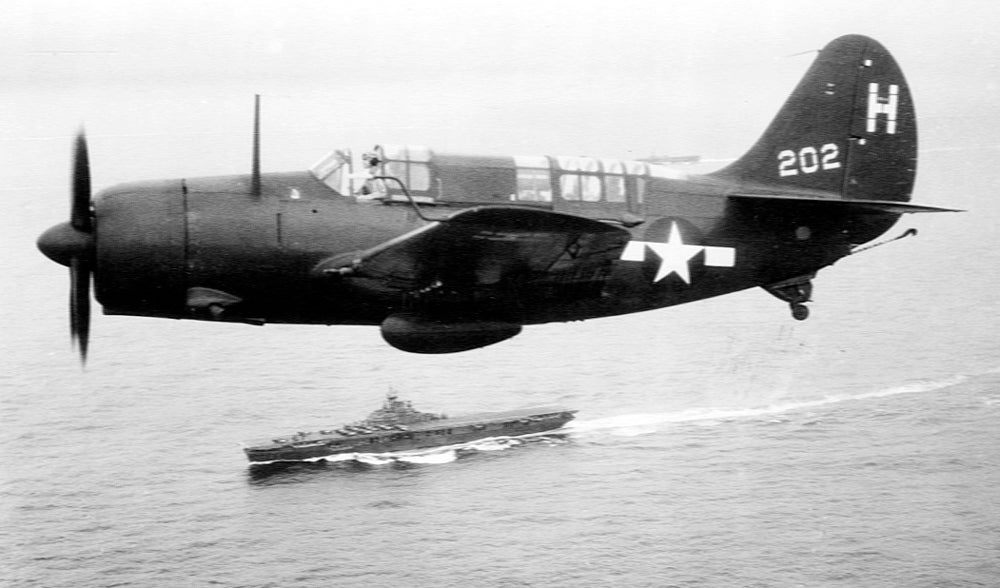
December 18, 1940 – The first flight of the Curtiss SB2C Helldiver,
a dive and torpedo bomber developed for the US Navy as a replacement for the
Douglas SBD Dauntless
and as a dive bomber for the US Army known as the A-25 Shrike. The Helldiver was considerably larger than the Dauntless, and featured heavier armament and an internal bomb bay. Early in its development, the Helldiver was plagued by structural deficiencies and poor handling, leading to loss of export customers and an investigation by the
Truman Committee
. Once its problems were solved, the Helldiver became the primary American dive bomber for the last two years of the war in the Pacific, though the difficulties with the Helldiver’s development caused Curtiss to lose favor with the US military. Over 7,000 Helldivers were produced between 1943 and 1945, and the final Helldivers were retired by the Italian Air Force in 1959
.
(US Navy photo)
!!! UNKNOWN CONTENT TYPE !!!

December 18, 1919 – The death of John Alcock. Born on November 5, 1892, Alcock received his pilot license in 1912, and began his career as a race pilot for the Sunbeam Motor Car Company . Alcock joined the Royal Naval Air Service at the outbreak of WWI, and received the Distinguished Service Cross for downing two enemy aircraft while piloting a Sopwith Camel , though he ended the war as prisoner after ditching his Handley Page bomber in the sea. Following his release at the end of the war, Alcock became a test pilot for Vickers , and gained fame when he and fellow pilot Arthur Brown became the first to cross the Atlantic Ocean, flying a modified Vickers Vimy bomber from St. John’s, Newfoundland to Clifden, Ireland, a voyage of 1,980 miles that took more than 16 hours. Alcock was killed in 1919 in the crash of his Vickers Viking on his way to an aviation expo in France. (Photo author unknown via Wikimedia Commons )
!!! UNKNOWN CONTENT TYPE !!!
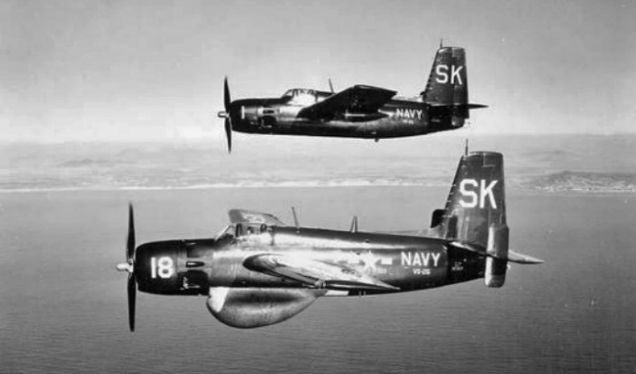
December 19, 1945 – The first flight of the Grumman AF Guardian, the first purpose-built airborne anti-submarine warfare (ASW) system. Since early radar systems were so large, no single carrier-borne aircraft of the day could carry both the radar and the weapons to attack a submarine. So the Guardian consisted of two aircraft, one hunter (AF-2W) with the radar equipment, and one killer (AF-2S) with weapons. Though cumbersome, this stopgap measure nevertheless proved effective, but the Guardian only served five years before being replaced by the Grumman S-2 Tracker , the first dedicated all-in-one carrier-borne ASW platform. (US Navy photo)
!!! UNKNOWN CONTENT TYPE !!!
!!! UNKNOWN CONTENT TYPE !!!
!!! UNKNOWN CONTENT TYPE !!!
!!! UNKNOWN CONTENT TYPE !!!
!!! UNKNOWN CONTENT TYPE !!!
!!! UNKNOWN CONTENT TYPE !!!
!!! UNKNOWN CONTENT TYPE !!!
!!! UNKNOWN CONTENT TYPE !!!
If you enjoy these Aviation History posts, please let me know in the comments. And if you missed any of the past articles, you can find them all at
Planelopnik History
. You can also find more stories about aviation, aviators and airplane oddities at
Wingspan
.
!!! UNKNOWN CONTENT TYPE !!!
 "Smallbear wants a modern Syclone, local Maple Leafs spammer" (smallbear94)
"Smallbear wants a modern Syclone, local Maple Leafs spammer" (smallbear94)
12/19/2017 at 12:42, STARS: 1
It’s not just the handling characteristics that got the B47 the description of a “six-engined fighter”... dayum it’s a beautiful rig
 "ttyymmnn" (ttyymmnn)
"ttyymmnn" (ttyymmnn)
12/19/2017 at 12:47, STARS: 1
Absolutely gorgeous. One of my all-time favorites.
 "For Sweden" (rallybeetle)
"For Sweden" (rallybeetle)
12/19/2017 at 12:48, STARS: 2
The Stratojet is also one of the most significant aircraft ever to fly; establishing the pressurized tube, swept wing, and underwing engine form that has dominated transport aircraft for 70 years.
 "ttyymmnn" (ttyymmnn)
"ttyymmnn" (ttyymmnn)
12/19/2017 at 12:49, STARS: 1
Yup.
 "For Sweden" (rallybeetle)
"For Sweden" (rallybeetle)
12/19/2017 at 12:53, STARS: 1
Yep

 "HammerheadFistpunch" (hammerheadfistpunch)
"HammerheadFistpunch" (hammerheadfistpunch)
12/19/2017 at 13:04, STARS: 1
2032 B47 bombers built for a service life of 30 years max at 63 million (adj) each. Thats nearly 6 a month for 30 years at a total run cost of 128 billion. Seems like a high price to pay for something that never really saw action and was unceremoniously replaced. Not to mention they were expensive as hell to keep in the air.
 "Ash78, voting early and often" (ash78)
"Ash78, voting early and often" (ash78)
12/19/2017 at 13:04, STARS: 2
“Two Ohio bros took a trip to the Outer Banks and you won’t believe what they did there! Caught on video!”
*Cut to shot of Orville and Wilbur from the waist up, high fiving each other.
I love imagining history as clickbait.
 "HammerheadFistpunch" (hammerheadfistpunch)
"HammerheadFistpunch" (hammerheadfistpunch)
12/19/2017 at 13:08, STARS: 1
So sad about the AN-70. I want propfans to make it.
 "facw" (facw)
"facw" (facw)
12/19/2017 at 13:14, STARS: 3
Just as well that it never saw action given that it’s purpose was to bring nuclear death. It presumably did have value in that role even if it was never used (much like we spend money on ICBMs even though we’ve never used one in combat).
 "HammerheadFistpunch" (hammerheadfistpunch)
"HammerheadFistpunch" (hammerheadfistpunch)
12/19/2017 at 13:17, STARS: 1
There is truth to that. Im just speaking to the idea of spending 128 billion and untold more just to fly around for 30 years. I guess it had deterrence value and you certainly can’t put a price on not being turned into plasma.
 "Yowen - not necessarily not spaghetti and meatballs" (yowen)
"Yowen - not necessarily not spaghetti and meatballs" (yowen)
12/19/2017 at 13:19, STARS: 0
Yeah, I went and read the wikipedia page on it. The 30% fuel economy improvement (as test on a McDonnell Douglas) is certainly interesting. But perhaps with advances in modern jet engines that gap has significantly narrowed, if not disappeared?
 "ttyymmnn" (ttyymmnn)
"ttyymmnn" (ttyymmnn)
12/19/2017 at 13:25, STARS: 1
If only for the pretty blue propellers.
 "HammerheadFistpunch" (hammerheadfistpunch)
"HammerheadFistpunch" (hammerheadfistpunch)
12/19/2017 at 13:25, STARS: 1
Gotta have the blue props
 "ttyymmnn" (ttyymmnn)
"ttyymmnn" (ttyymmnn)
12/19/2017 at 13:27, STARS: 0
What price can you put on preventing nuclear war?
 "Chariotoflove" (chariotoflove)
"Chariotoflove" (chariotoflove)
12/19/2017 at 13:38, STARS: 3
We need to have an aviation dream garage (hanger). A DC-3 would be in mine.
 "ttyymmnn" (ttyymmnn)
"ttyymmnn" (ttyymmnn)
12/19/2017 at 13:43, STARS: 2
I’d have an F-86 in mine.
 "Chariotoflove" (chariotoflove)
"Chariotoflove" (chariotoflove)
12/19/2017 at 13:48, STARS: 1
solid choice

12/19/2017 at 13:59, STARS: 0
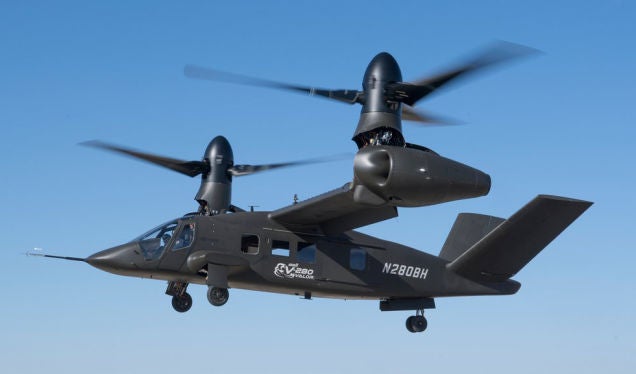
Shut up and take my money!
C-141 in MAC livery

C-141 in Euro One “Lizard” camo
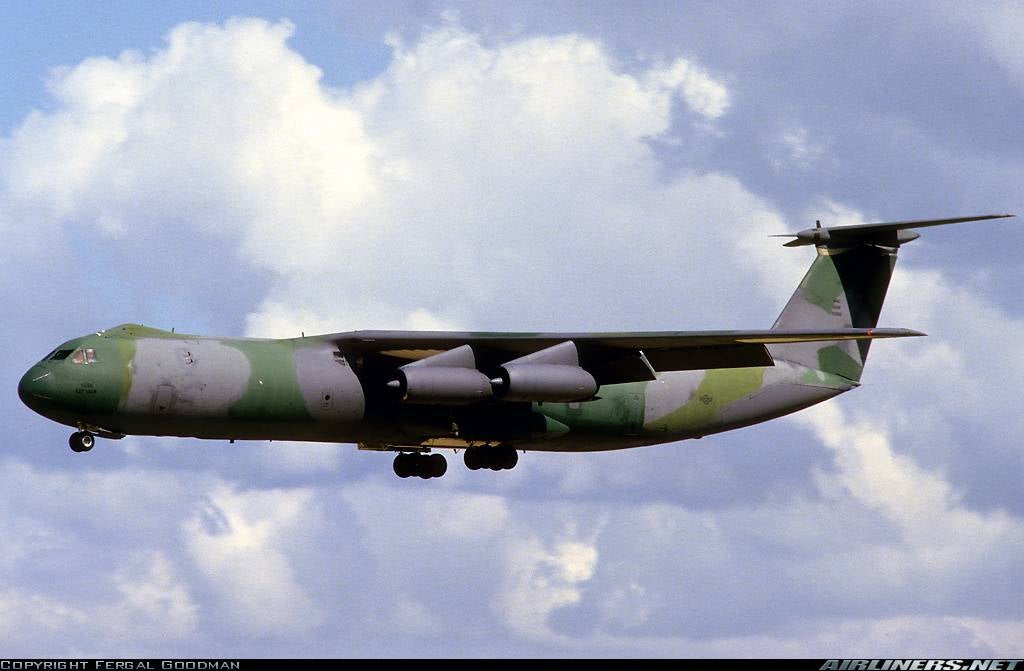
I can’t decide which looks best, but they both look right.

12/19/2017 at 15:30, STARS: 1
Here’s mine:
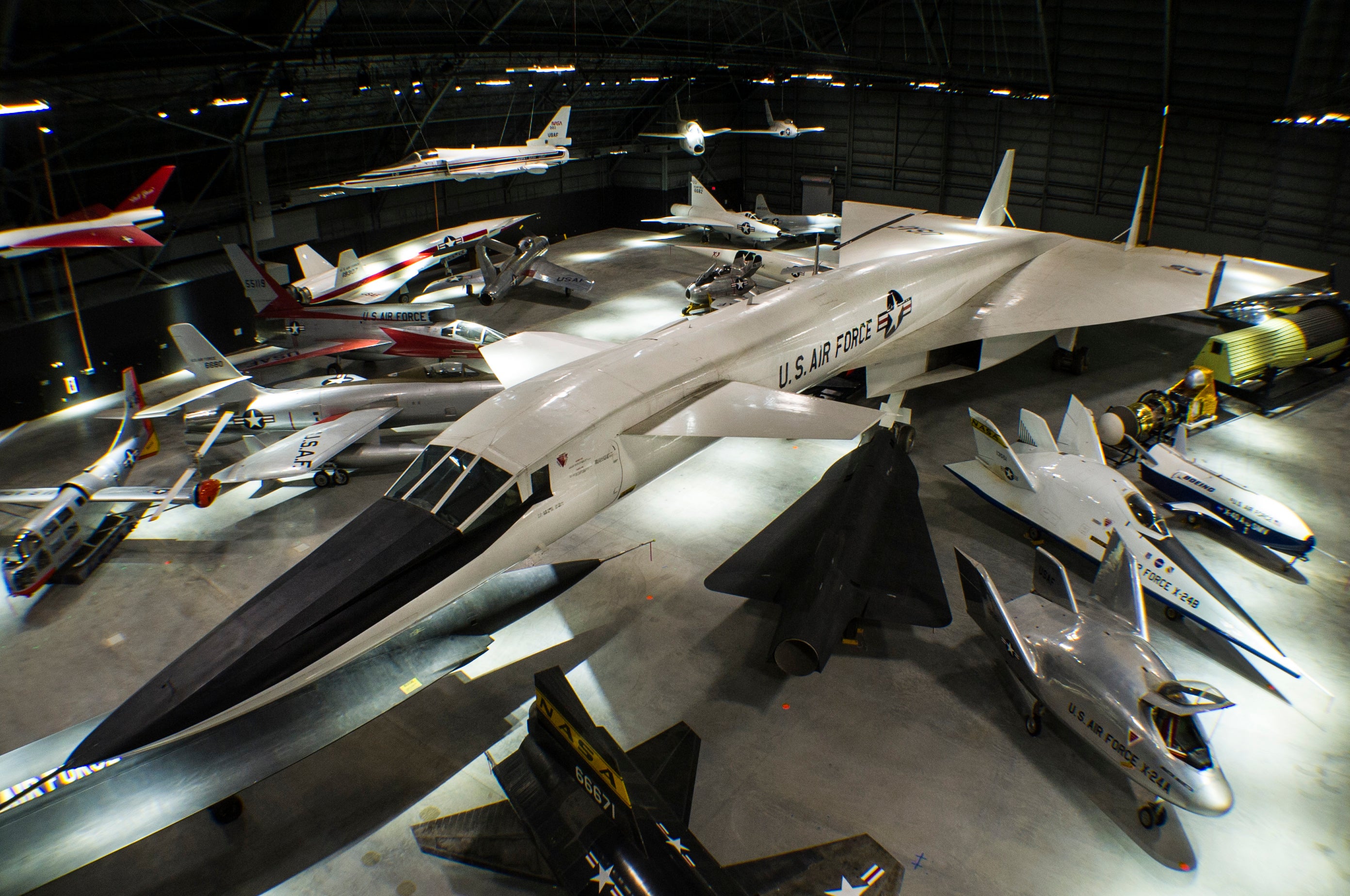
 "Chariotoflove" (chariotoflove)
"Chariotoflove" (chariotoflove)
12/19/2017 at 15:32, STARS: 1
I like your style.

12/19/2017 at 15:49, STARS: 1
I mean, it’s probably noisy as hell, and no doubt sucks down oil and avgas like there’s no tomorrow, but I would absolutely DD that XV-3 .
 "Chariotoflove" (chariotoflove)
"Chariotoflove" (chariotoflove)
12/19/2017 at 15:53, STARS: 1
There are no neighbor complaints and HOAs in dream hangar.
 "Dave the car guy , still here" (a3dave)
"Dave the car guy , still here" (a3dave)
12/19/2017 at 16:00, STARS: 0
I totally stopped dead at the opening picture. I was born just 55 miles from there and grew up on the Outer Banks within 6 miles of the Wright Brothers site. There was a time when we used to sneak onto the grounds to skateboard and walk the flight marker rail like a balance beam. Have stood there many time wondering what it was like when the first flight happened. Back then there were few people on the beach, no cottages etc almost barren. I even knew a family in high school who lived in a Kitty Hawk village home where the Wright Brothers once stayed while they were getting things set up to live there.
 "ttyymmnn" (ttyymmnn)
"ttyymmnn" (ttyymmnn)
12/19/2017 at 16:44, STARS: 1
It’s a remarkable photograph. Talk about capturing a moment of history. I think we chatted last year when I made the long post about the WBs. I spent many years of my youth in Norfolk, and we made a few trips down to the Outer Banks for vacations. I’ve still got a South 13 sticker on my van. I love that place. Thanks for reading.
 "Dave the car guy , still here" (a3dave)
"Dave the car guy , still here" (a3dave)
12/19/2017 at 18:55, STARS: 1
Yes, I think I recall that now. I’m not sure if I told you back then but at least two of my classmates were descendants of the Coast Guardsmen who were present. One was an extra with James and Stacey Keach in the Wright Bros film from the early 70's.
https://archive.hnsa.org/conf2004/papers/price.htm
 "ttyymmnn" (ttyymmnn)
"ttyymmnn" (ttyymmnn)
12/19/2017 at 19:15, STARS: 1
http://oppositelock.kinja.com/thanks-for-posting-that-s-my-home-town-have-walked-th-1790247355
 "Kiltedpadre" (kiltedpadre)
"Kiltedpadre" (kiltedpadre)
12/19/2017 at 20:40, STARS: 1
I’d be torn between a standard DC-3 so I could hear the radial sing, and a DC-3 converted to turboprop.
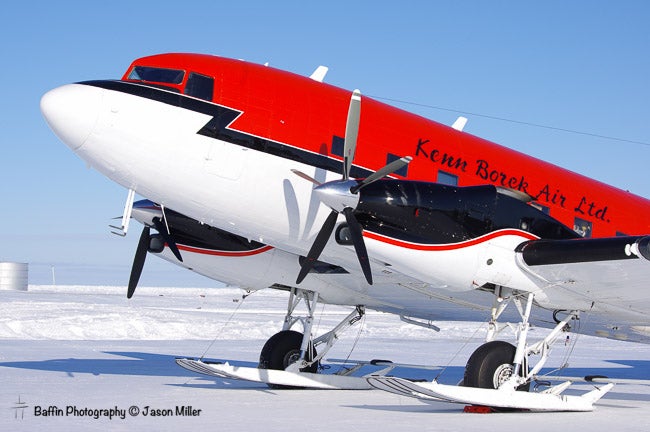
Even better if it’s on floats.
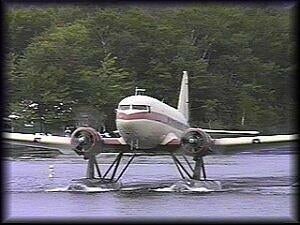
 "Chariotoflove" (chariotoflove)
"Chariotoflove" (chariotoflove)
12/19/2017 at 20:46, STARS: 0
So get both.
 "Kiltedpadre" (kiltedpadre)
"Kiltedpadre" (kiltedpadre)
12/19/2017 at 21:12, STARS: 0
Well, if I can have two planes we’ll go with a turbine DC-3, and get a Grumman Mallard to satisfy the radial soundtrack needs.
 "Chariotoflove" (chariotoflove)
"Chariotoflove" (chariotoflove)
12/19/2017 at 21:20, STARS: 1
Well, it’s called dream hangar, not reasonably practical hangar. I wasn’t going to stop at two.